The glutes are meant to be strong in human beings. The following exercises – including detailed descriptions, tips, photos, and video – will help you build stellar, well-shaped buttocks.
The Benefits of Strong Glutes
The gluteal muscles that comprise a person’s buttocks are a vital part of a human’s functional movement – even more important than most athletes realize:
- People with weak glutes are more likely to round excessively at the lower back, potentially setting themselves up for lower back pain or even injury.
- Strong glutes exert a beneficial posterior pull on the pelvis – to help maintain proper spine alignment.
- When the glute muscles aren’t strong enough to do their share of the work, other areas of the body have to take up the slack, including the sensitive knee joints.
Save Our Glutes! (The Epidemic of Saggy Bottoms)
Aside from the practical benefits of possessing strong glutes, there is also – let’s face it – a strong aesthetic benefit, too.
We have an epidemic of saggy bottoms in today’s sedentary culture:
- For women, there is a rise of “skinny fatness,” in which physiques – that might look fair in clothes – without clothes reveal textured, droopy or weak areas. (Even when there is body fat, fat cells present a better texture when they sit tautly across developed muscle tissue.)
- For men, there seems to be a constant temptation to work the upper body twice as much as the lower body, which results in asymmetry. These are the fellows that will wear a t-shirt but who won’t wear shorts. There are a lot of these fellows.

A good glute workout promotes the symmetrical development of the legs while targeting all three of the gluteal muscles.
The idea is to create firm, lifted, roundly shaped buttocks. This will help you to feel better, too.
Additionally, you’ll be crafting legs that are even – quadriceps, hamstrings, and gluteals are developed proportionally with strong, defined calves to match.
How Your Glutes Function Optimally
The gluteus group is built from three muscles – maximus, medius, and minimus. The maximus is intended to be among the most powerful of our body’s muscles.
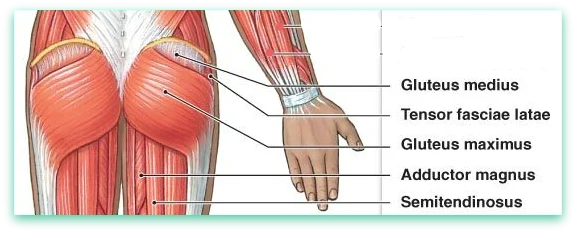
According to Bret Contreras – considered a top glute expert among exercise physiologists and athletes – a mistake many make when training the glutes is not varying the direction of exercise movements or planes:
- Frontal-plane exercises are suited for lateral-side movements.
- Sagittal-plane exercises refer to forward and backward movements.
- Transverse-plane exercises indicate rotary movements that allow for engaging some part of the circular aspect of the rotating hip joint.
- It’s also a smart idea to pepper some static-isometric exercises into a glute workout, along with the usual dynamic movements.
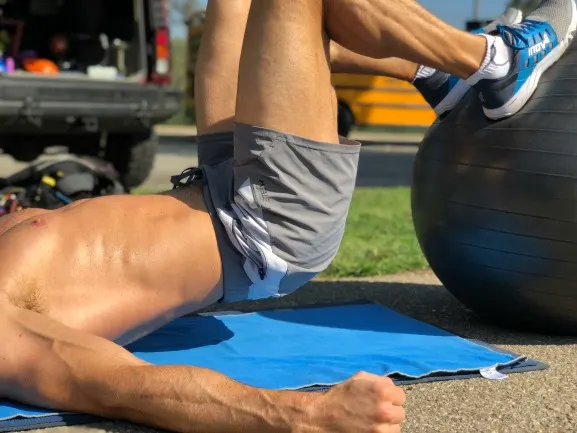
Examples of 13 results-effective buttocks exercises – that work along all of these planes and styles – are provided below.
How to Get a Bubble Butt
If you’re an experienced exerciser, you are hopefully already doing some variation of squats and deadlifts regularly.
Squats and deadlifts are part of an effective workout – for all body muscles, including the glutes.
But if you want a bubble butt, it will probably take more than just those two fundamental exercises.
Below is a complete glute workout comprised of 13 other exercises that can be completed in under an hour. Some of these movements hit the glutes directly, while others engage the gluteals indirectly:
- There is a warm-up exercise, followed by four glute workout circuits.
- Each circuit (including the warm-up) is done three times.
- There are several exercises within each circuit.

- Do each exercise within the circuit consecutively without rest, then take a 2-minute rest before repeating the circuit.
- Use a timer! Limiting your rest between circuits to only two minutes keeps your heart rate elevated and your sweat going.
- After you complete your third time through a particular circuit, you move on to the next circuit in the series.
Do this unique workout once each week, and you will begin to see – and feel – positive differences in the shape, lift, strength, and texture of your buttocks.
Exercises for Firm Buttocks
A bubble butt can be yours! Try these exercises for firm buttocks.
As always, consult your medical doctor before beginning any significant changes to your movement patterns, nutrition, or lifestyle habits. For additional information on glute conditioning, see the sources listed below in this article.
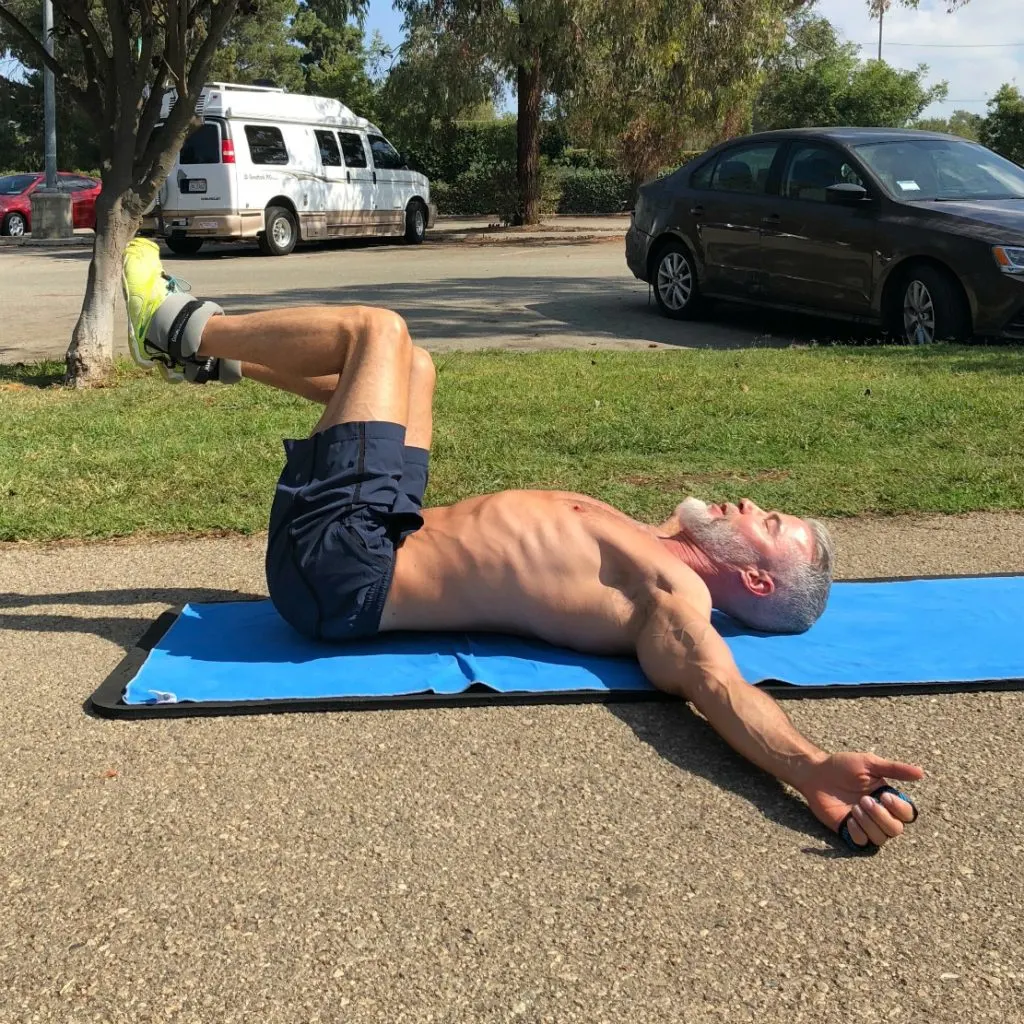
Warm-Up: Windshield Wipers followed by Light Jog
- Advanced-level athletes can use ankle weights.
- Go slowly, keeping your knees together and your navel pulled in tightly.
- Lower your knees to one side of your body, then alternate sides. 16 repetitions (8 reps each side).
- Though it’s tempting to hold your breath, breathe fully and calmly.
- After your windshield wipers, stand up and do a light one-minute jog in place, or jog to the end of the block and back.
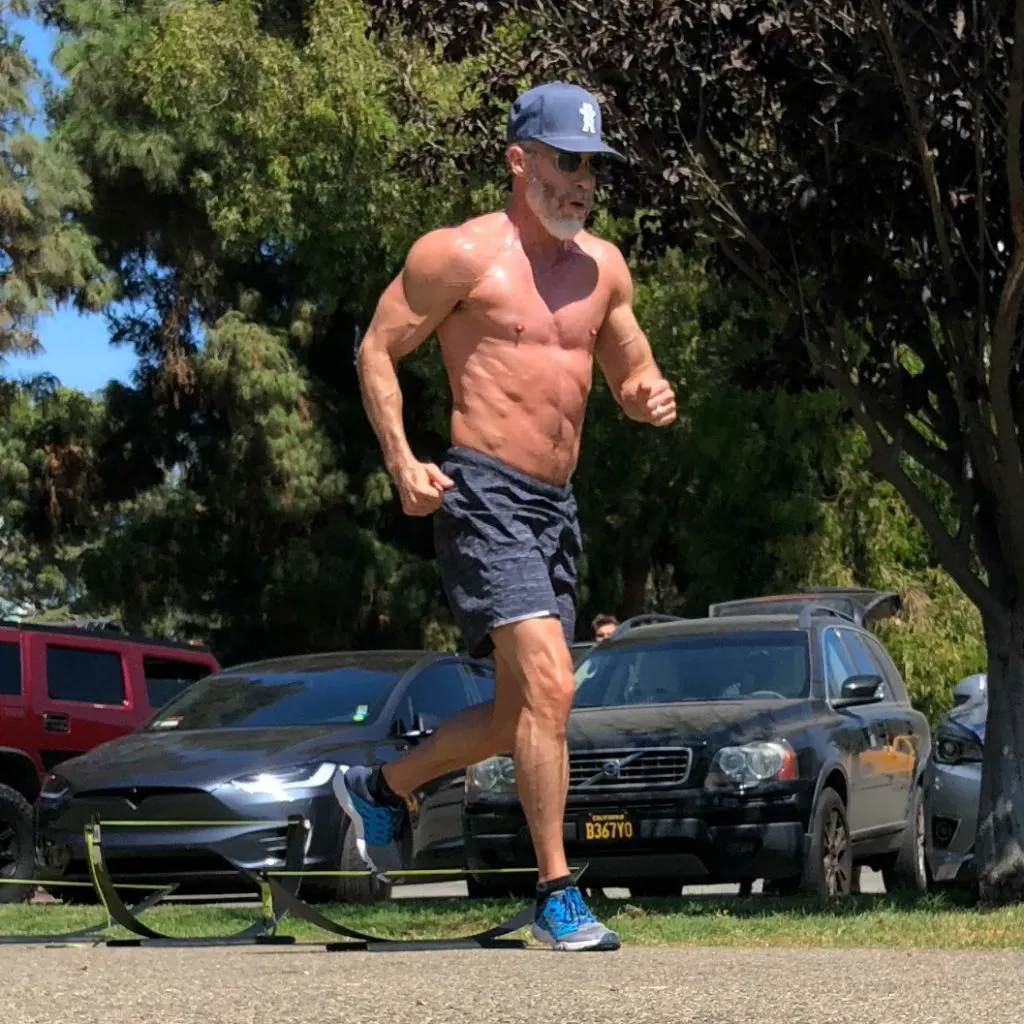
First Circuit for Glutes:
- One-legged Bridge Openers
- Bridge Thrusts on Ball
- Kettlebell Full Kneel-Down Squat/Lunges
One-legged Bridge Openers
This exercise is a single-leg glute bridge hold with a 90-degrees bent-knee external rotation.
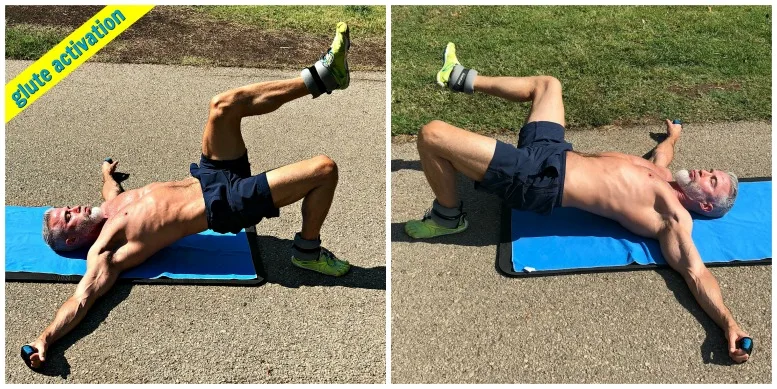
- With one leg elevated, drive the supporting heel into the ground and focus on creating a deep squeeze in the working glute as you approach the top. Now, stay elevated as you rotate that top leg out and in.
- Keep your glutes and abdominal muscles activated.
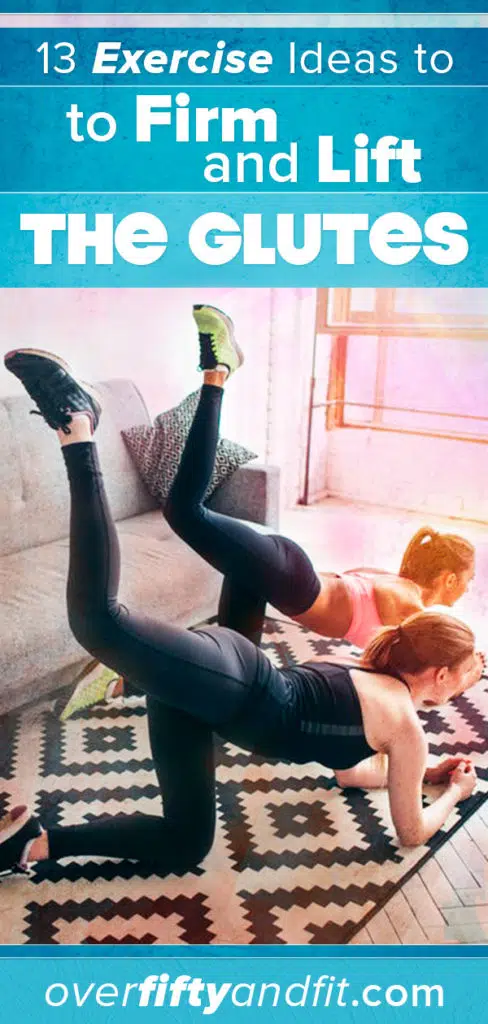
- If you want, you can wrap ankle weights around your lower calves.
- 16 repetitions (8 reps each side).
- You’re still kind of warming up here, so emphasize the quality of contraction over speed.
Glutes Bridge with Stability Ball
This exercise is a good choice for your first circuit because it warms up the spine and raises body heat.
- As you lift your hips, engage your lower abdominal plate, compressing the top ribs and pulling the navel in firmly.
- As you near the top of your bridge, drive your feet down into the ball, contract your glute muscles intensely and exhale.
- Inhale on the way down, articulating the vertebrae of your spine, relaxing your glutes completely at the bottom.
- Go slowly. 3 Sets, 8 reps each.
Kettlebell Kneel Down Lunges
To build more youthfully shaped buttocks, you need to try exercises to which your body is mostly unaccustomed.
Kettlebell kneel-down lunges ought to do the trick.
- Hold a kettlebell (or any type of weight) in front of your chest. Kneel, one knee at a time, then stand back up, one leg at a time.
- Then switch, kneeling again but starting with the other leg.
- Remember to keep your navel pulled in tightly and your spine tall.
- The idea is to drive your energy upward like a string pulling from the top of your head. This will protect your knees.
- Also, remember when standing back up to reach your foot out far enough in front of you so that the kneecap is directly over the ankle.
- Use plenty of padding under your knees! You don’t want to collapse all of your body’s weight down into one kneecap. Imagine the energy in your body driving upward to the sky.
- 3 sets of 12 (6 reps each leg).
Second Circuit for Glutes:
- Reverse Walking Kettlebell Lunges
- Single-Leg Booty Press Back with Resistance Band
- Reverse Duck Walk
Reverse-Direction Walking Kettlebell Lunges
Many people walk lunges, but not many think to go in the reverse direction.
Because your body isn’t accustomed to this exercise, it’s likely to respond positively.
This exercise will not only help strengthen your glute and leg muscles but will develop your agility and balance as well.
- It’s the same-side hand as your forward knee that passes the kettlebell under to your other hand.
- The trick to doing this exercise effectively is to reach your leg far enough behind you so that your front knee is positioned over your front ankle but not so far back that you lose your balance.
- 12 lunges (6 reps each leg).
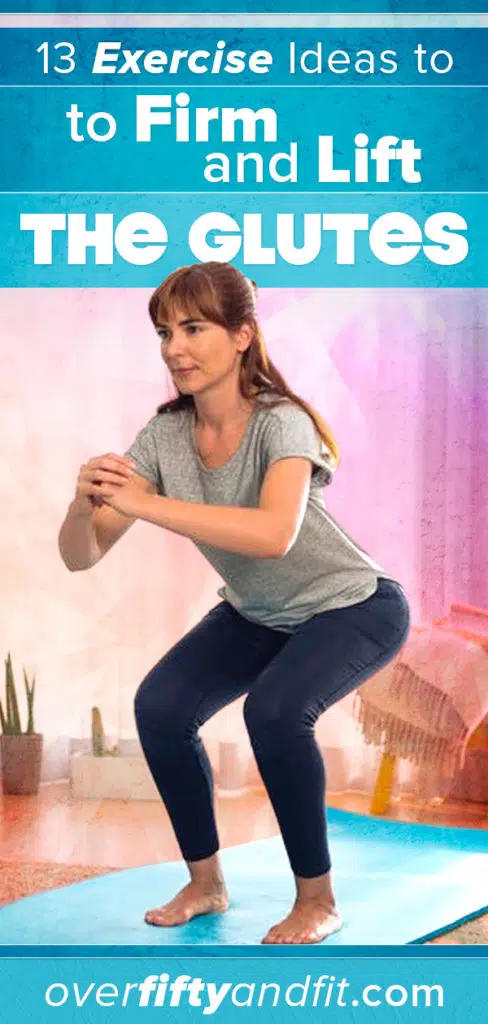
Single-Leg Booty Press Back with Resistance Band
Using a resistance band to strengthen the glute muscles means that the further into the rep you move, the harder the exercise becomes.
Bands are excellent for shaping, firming, and lifting the booty area – and especially important after the age of 50 when, without strength, the glutes can deactivate and lose the war with gravity.
- Remember to slightly soften that supporting knee.
- 3 sets of 10 reps (each leg).
Reverse Duck Walk for Glutes
Sylvester Stallone made this exercise famous as Rocky Balboa training for an upcoming fight.
This time, it’s to be done backward.
- Stay low, keep the glutes active and the abdominal wall pulled in.
- Long spine, chest open, scaps set, and hold a weight in front of you to make it more challenging.
- 3 sets of 12 reps.
A particular person you know would find this article interesting or helpful. I encourage you to share it with them.
Third Circuit for Glutes:
- Kettlebell Windmills
- Overhead Squat
- Frog Pumps
Kettlebell Windmills
Kettlebell windmills involve the shoulders, triceps, and glutes.
I think of this movement as a sort of deadlift variation, so for me, this is an axial semi-straight leg exercise. This exercise can be so effective because it’s so compromising.
You have to concentrate on good breathing, stabilizing your shoulder, stretching your hip, and initiating the come-up from your legs and glutes.
- If you don’t concentrate, you might be tempted to let your lower back do most of the work, which is not the purpose of this movement.
- Please proceed cautiously on this one. Keep your core tight, and if you feel any pain in your lower back, stop.
- 3 sets of 8 reps (each side).
Overhead Squat
Most people don’t do overhead squats, and that’s a shame – because the genius of overhead squats is that your glutes and posterior deltoids (two often-neglected muscle groups) are forced to jump in and help out to complete the exercise successfully.
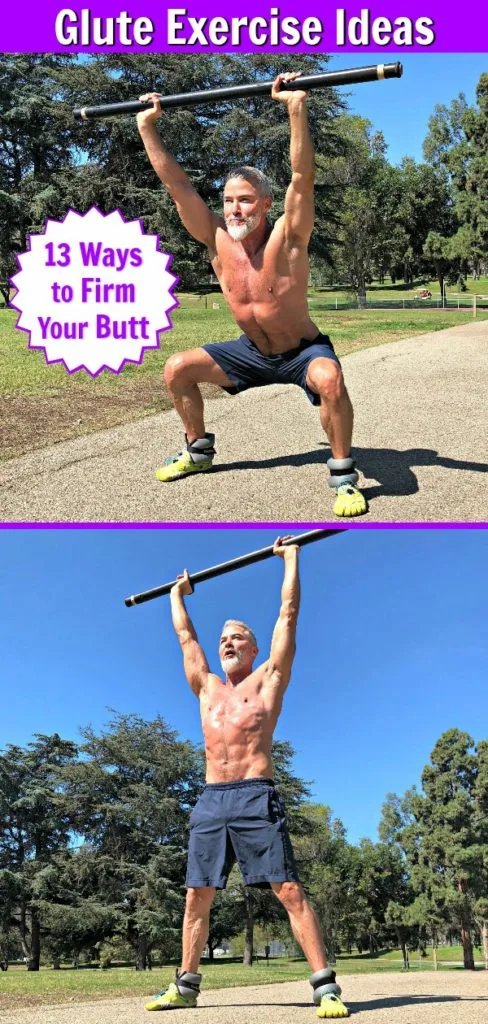
- Keep your back tall, and be especially mindful of how the soles of your feet fully connect to the ground.
- 3 sets, 8 reps each. An axial-extension exercise.
Athletes must learn how to derive maximum power from the hips and legs. For this advancement to take place, a foundation of adequate core strength and hip mobility is an absolute prerequisite. Strong glutes are critical for a properly functioning body. They are the keystone muscles that keep everything else in line. – Bret Contreras
Dumbbell (or Plate) Frog Pumps for Glutes
Bret Contreras believes that most people have glutes that are weak and “underpotentialized” – and that strong, powerful buttocks are what separate a healthy, athletic physique from an average one.
To solve this dilemma, Contreras has made hip thrusts popular.
The brilliance of hip thrusts is that they put the maximum effort from the glutes toward the top end of the rep (unlike squats and deadlifts, which mostly engage the glutes only at the bottom and middle ranges, respectively).
This frog pump variation works your glutes in a way that will likely feel unfamiliar to you.
- Press your heels into one another throughout the rep, and keep your top rips compressed (no over-arching of the back).
- 3 sets, 10 reps each.
Fourth Circuit for Glutes:
- Hip Thrusters
- Kettlebell Swings
- Reverse Hamstring Curls on Ball
- Straight-Leg Bridge Thrusts on Ball
Hip Thrusters
There is a reason that nearly everyone loves hip thrusters. You can actually feel your glutes working.
An anteroposterior bent-leg exercise. For once, your quads aren’t trying to steal the show. Outside, you can use a band and/or a bodybar on top of a stability ball. Inside the gym, you can use the smith machine.
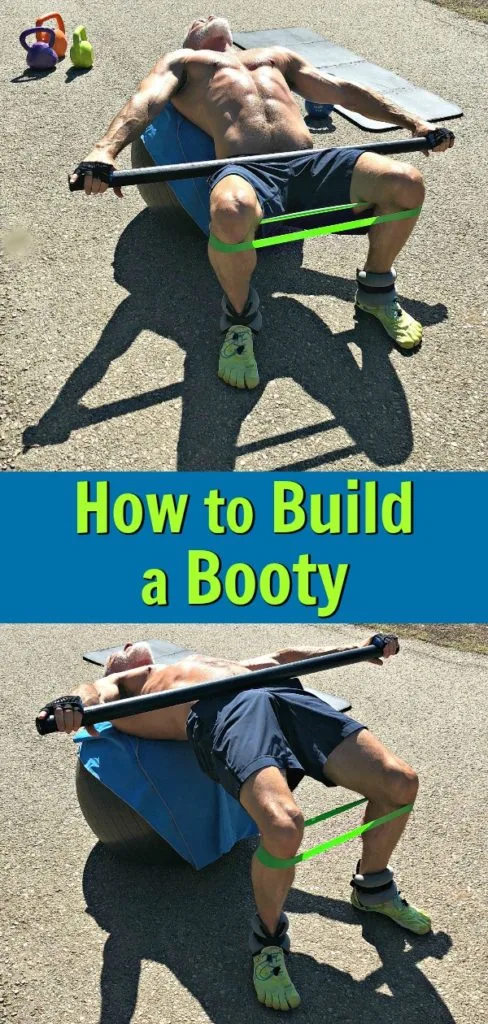
- 3 sets of 8, finish with 8 pulses at the top.
- Go for the peak contraction!
Kettlebell Swings
I often see people at the gym doing kettlebell swings without the swing. Instead, they’re doing a sort of messy front-arm raise.
But a good kettlebell swing isn’t all shoulder work.
A good swing has thrust, with the momentum driving energy not just forward but up as well.
Where does this energy originate? From the glutes. It’s an anteroposterior extension exercise.
- Imagine that your arm is swinging due to your powerful pelvis, not because you’re pulling the kettlebell up only with your deltoids.
- This exercise is great toward the end of your glute workout, with a final push and lots of sweat.
- 3 sets, 20 reps each.
Hamstring Curls on Stability Ball
You might think that you wouldn’t be able to get good glute engagement or a nice hamstring pump going with just a simple stability ball, but you’d be mistaken. You can get some solid work done with focused isolation and lung-expanding breathing.
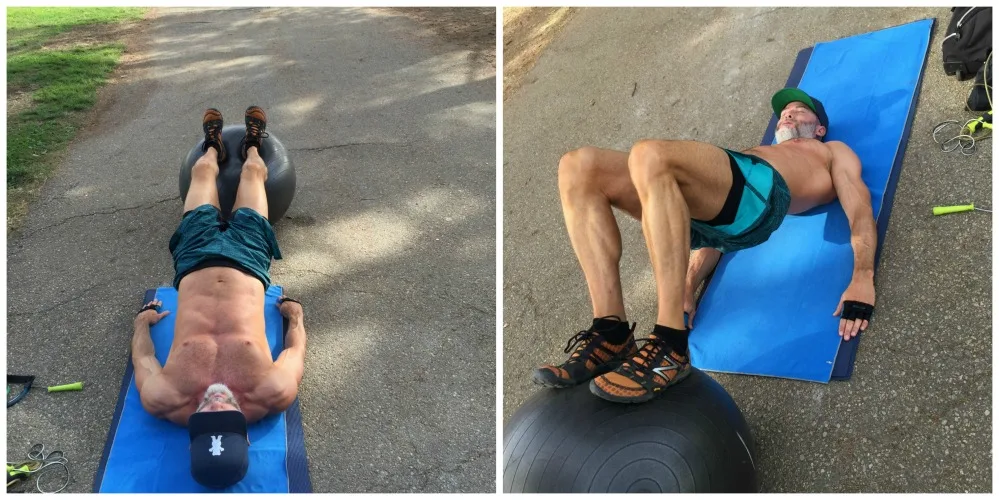
An anteroposterior flexion exercise. Your hips stay elevated – and your glutes activated – during the entire set, with your legs lengthening then pulling bent for each repetition.
- The whole time, imagine your core is a corset of firm muscles that encases and protects your vital organs and spine around your entire midsection. Keep it active!
- 3 sets, 12 reps each (with a nice, intense pause and full exhalation at the point of hamstring contraction).
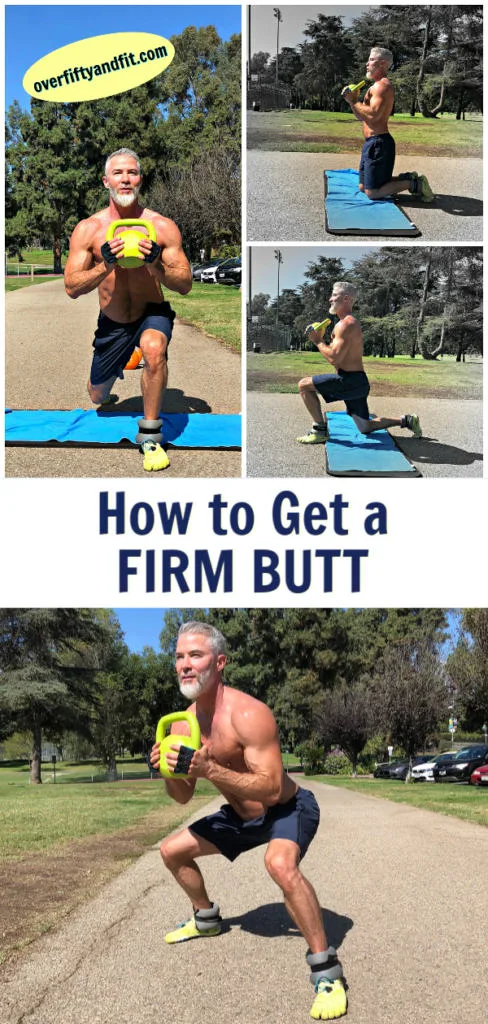
Straight-Leg Bridge Thrusts on Ball
- Stabilize feet on the ball with straight legs.
- Stabilize back of shoulders on the mat.
- Center your pelvis, compress your top ribs, and thrust your hips upward with explosive speed as you exhale, contracting your gluteal muscles.
- Lower your hips back down to the mat slowly as you inhale.
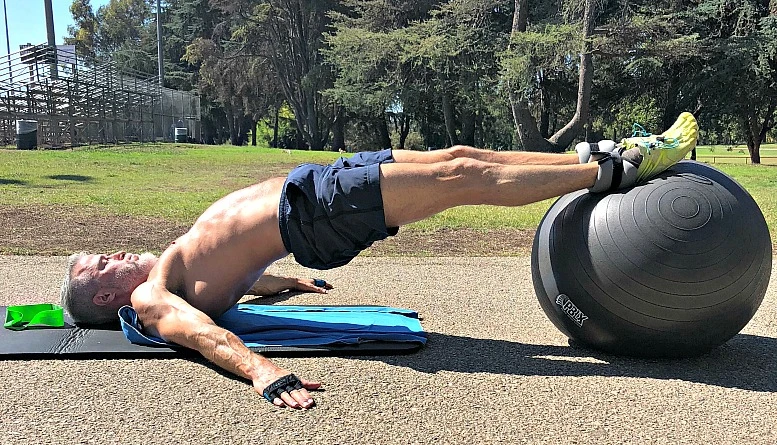
ADVANCED-LEVEL BONUS: Straight-Leg Bridge Kickbacks on Ball for Glutes
This is one of those exercises that looks easy when someone else does them. But when you do them yourself, you find out what an ass-kicker they are. This is an anteroposterior straight-leg exercise.
- Feet on the ball, legs straight – but knees are not locked.
- Press your top ribs in for a super-tight core, then raise your hips and hold.
- Pulse at the top.
- Then finish off with kicks.
- 3 sets, 12 reps each.
Conclusion on Building Powerful Buttocks
When pursuing a strong, shapely derriere, it’s evident that the benefits extend far beyond mere aesthetics.
The gluteal muscles, often neglected in traditional workout routines, are pivotal in maintaining optimal functionality and preventing potential health issues.
The above exercises – meticulously detailed with descriptions, tips, and visuals – offer a solution to sculpting firm, lifted, and roundly shaped buttocks.
However, it’s also essential to remember the significance of consistency.
Incorporating the suggested glute workout into your fitness routine once a week promises positive transformations not only in the shape and lift of your buttocks but also in overall strength and texture.
These exercises go beyond the surface – they contribute to the symmetrical development of your legs and promote a balanced physique.
Thanks to Ákos Farkas for his help with this article.
Additional Sources on Glute Development:
- Bodyweight Strength Training Anatomy by Bret Contreras
- The Glute Lab: Strength & Physique Training in San Diego

Leg Day: A Lower-Body, Functional-Training Workout • Over Fifty and Fit
Saturday 4th of January 2020
[…] Women, a common mistake is doing mostly isolation exercises for the lower body and forgetting to do enough compound […]
How to Plan and Organize Your Workouts Using Pinterest
Friday 1st of November 2019
[…] type in what your curious about, “How to Cook Turkey Bacon in the Oven,” or “How to Make my Glutes Firmer,” or “Best Way to Clean My Garage,” or whatever is on your mind. Pinterest […]
11 Mobility Maneuvers to Help Keep Your Joints Supple
Tuesday 13th of August 2019
[…] mindful of your lower back; keep your core active (so, don’t fully relax your glutes or your abdominals while you’re leaning your legs to the […]
Mat Exercise Program for Strength and Flexibility – A No-Gym Workout
Monday 12th of August 2019
[…] Roll Ups exercise, only you’re coming from the other direction. This time, it’s your lower body that rolls […]
The Pilates Chair Workout • Over Fifty and Fit
Monday 6th of May 2019
[…] your glutes. However, you want to do the opposite. Pretend you’re sitting on hot coals. Activate the glutes and try to direct your energy upwards away from the […]